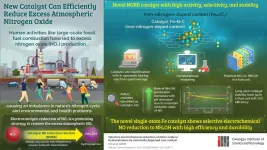When Medicare chips in on hepatitis C treatment for Medicaid patients, everyone wins
Joint Medicaid-Medicare coverage of treatment would save $1 billion over 25 years
2021-05-20
(Press-News.org) Untreated hepatitis C can lead to serious and life-threatening health problems like cirrhosis and liver cancer. Direct-acting antiviral therapies introduced in recent years are highly effective, with cure rates above 95%.
But most Medicaid beneficiaries with hepatitis C don't get these drugs, which cost $20,000-$30,000, due to state budget constraints.
Now, a new USC study finds that a Medicaid-Medicare partnership could cover the lifesaving medications -- and still save $1 to $1.1 billion over 25 years. Medicaid is a joint federal and state program that provides health coverage for low-income families and others. Medicare is the federal health insurance program for people 65 and older.
The study was published today in the American Journal of Managed Care.
Researchers with the USC Schaeffer Center for Health Policy and Economics studied the state of Maryland's "total coverage" proposal, where the state receives a credit from Medicare to offset Medicaid investments in hepatitis C treatments that could lead to Medicare savings. Hepatitis C complications tend to snowball as time goes on, leading to costly treatment by the time the patient is eligible for Medicare.
"Our findings show that Medicare has significant financial incentives to partner with Medicaid to treat the majority of hepatitis C cases," said William Padula, a fellow with the USC Schaeffer Center and an assistant professor of pharmaceutical and health economics at the USC School of Pharmacy. "Joint Medicaid-Medicare coverage provides a cost-effective solution to treat all patients now to reduce harm caused by chronic infection in the United States."
Modeling different treatment options for hepatitis C
Padula and colleagues developed a model to simulate three different pathways for patients going through the care continuum for hepatitis C. The first pathway simulated standard coverage with 50% probability of screening for the virus and 20% probability of treatment with direct-acting antiviral therapies -- reflecting current state policies on screening and coverage decisions.
Two additional models simulated Medicare credits to the state Medicaid program. One was a risk-stratified total coverage model which assumed the probability of screening at 80% and a treatment rate of 60%; the other model simulated total coverage with assumed 80% probability of screening and 100% treatment rate.
The study found that the total coverage model saved $158 per patient and the risk-stratified coverage saved $178 per patient, compared with standard care. Total coverage would save $1 billion and risk-stratified total coverage would save $1.1 billion over the course of 25 years.
The researchers say their model allows states to calculate the costs and savings of a total coverage policy and state public health agencies should explore using it to meet their needs.
"Maryland may be one of the first states to pilot the concept of a total coverage solution for hepatitis C treatment through joint Medicare-Medicaid payments, but all 50 states are grappling with this challenge," Padula said. "Cost sharing between the two programs will also improve the lives of patients and minimize the probabilities of future infection."
INFORMATION:
Additional authors included Jonathan S. Levin, Joy Lee and Gerard F. Anderson. Funding was provided by Arnold Ventures (formerly the Laura and John Arnold Foundation) and the National Institutes of Health (KL2 TR001854).
ELSE PRESS RELEASES FROM THIS DATE:
2021-05-20
For coffee drinkers, a common scenario might involve drinking an extra cup only to end up with a racing heart and a subtle reminder to themselves to cut down the caffeine. But for those who have a different thinking pattern, one that includes heart-focused anxiety, the racing heart might conclude with the fear of a heart attack and a trip to the emergency room.
It turns out young Latinx adults who experience heart-focused anxiety could be at greater risk for mental health disorders.
"We have empirical evidence that individual differences in heart-focused anxiety are related to more severe co-occurring anxiety and depressive symptomatology among a ...
2021-05-20
MSU researcher is studying, raising awareness about the role of sex in the efficacy of vaccines that make use of nanomedicine.
If there's one take-home message for the general public about the coronavirus vaccines approved in the U.S., it's that they are remarkably effective.
But Michigan State University's Morteza Mahmoudi is raising awareness about an important subtlety: The vaccines developed by Moderna and Pfizer-BioNTech appear to work slightly better for men than for women.
Both vaccines use tiny orbs, or nanoparticles, to deliver their active ingredients to cells in our immune systems. For years, Mahmoudi has been studying how and why nanomedicines -- therapies that use nanoparticles -- can affect patients differently based on their sex and ...
2021-05-20
A team of researchers at the University of Ottawa has found a way to use visible light to transform carbon dioxide gas, or CO2, into solid carbon forms that emit light. This development creates a new, low-energy CO2 reduction pathway to solid carbon that will have implications across many fields.
We talked to lead author Dr. Jaspreet Walia, Post-Doctoral Fellow in the School of Electrical Engineering and Computer Science at the University of Ottawa, and research lead Dr. Pierre Berini, uOttawa Distinguished Professor and University Research Chair in Surface Plasmon Photonics, to learn more.
Please tell us about your team's discovery.
Pierre ...
2021-05-20
COLUMBIA, Mo. -- Passports are a tangible way of showing where one has traveled, as the stamps provide a chronological order that traces an individual's journey across international borders. When an object's origins are not readily apparent, a variety of sources can be relied upon to learn more, which might include labels, sales receipts, foreign translations, oral histories, GPS coordinates and itemized personal possessions.
That documentation is an example of provenance, or the origins of an object and where it has traveled throughout history. Sarah Buchanan, an assistant professor in the University of Missouri's College of Education, is an archivist, a professional who assesses, collects and preserves various artifacts and archives them ...
2021-05-20
Our reliance on fossil fuels as a primary energy source has pushed air pollution to an all-time high, resulting in several environmental and health concerns. Among the major pollutants, nitrogen oxide (NOx) accumulation can cause severe respiratory diseases and imbalance in the Earth's nitrogen cycle. Reducing NOx accumulation is, therefore, an issue of utmost importance.
Recently, the conversion of NOx into harmless or even useful nitrogen products has emerged as a promising strategy. Particularly appealing to scientists is the reduction of NOx to hydroxylamine (NH2OH), which can be utilized ...
2021-05-20
A large-scale research project at the University of Alaska Fairbanks Geophysical Institute has revealed insight into the relationship between surface debris on glaciers and the rate at which they melt.
The work is the first global assessment of Earth's 92,033 debris-covered glaciers and shows that debris, taken as a whole, substantially reduces glacier mass loss.
The results will affect sea level rise calculations and allow for improved assessment of hazards faced by nearby communities.
"This is the first step to enable us to start projecting how these debris-covered glaciers are going to evolve in the future and how they're going to affect glacial runoff and sea level rise," said glaciologist ...
2021-05-20
May 20, 2021 - Comets that circle the Sun in very elongated orbits spread their debris so thin along their orbit or eject it out of the solar system altogether that their meteor showers are hard to detect. From a new meteor shower survey published in the journal Icarus, researchers now report that they can detect showers from the debris in the path of comets that pass close to Earth orbit and are known to return as infrequent as once every 4,000 years.
"This creates a situational awareness for potentially hazardous comets that were last near-Earth orbit as far back as 2,000 BC," said meteor astronomer and lead author Peter Jenniskens of the SETI Institute.
Jenniskens is the ...
2021-05-20
Building more homes and buildings with wood has been on the radar for years as a way to offset carbon emissions, though construction companies have been hesitant to take the material in broader use. A study at Aalto University in Finland is now the first to show that building with wood can be a sound investment.
The team analysed statistical data from real estate sales in the Finnish capital of Helsinki and two suburbs, from 1999 to 2018. Of these, timber-built homes made up 2.23% of cases. The findings show that multi-storied buildings made out of wood sold for an average of 8.85% more than those made from other materials.
Previous research has pointed to perceptions of higher costs in wood construction, ...
2021-05-20
Biologist Sasha Mendjan at the Austrian Academy of Sciences in Vienna and his team have used human pluripotent stem cells to grow sesame-seed-sized heart models, called cardioids, that spontaneously self-organize to develop a hollow chamber without the need of experimental scaffolds. This advance, which allows for the creation of some of the most realistic heart organoids to date, appears on May 20th in the journal Cell.
Previously, scientists have built 3D cardiac organoids via tissue engineering, an approach that generally involves assembling cells and scaffolds like building a house out of brick and mortar. But these engineered organoids do not have the same physiological responses to damages as human ...
2021-05-20
Swifts aren't called "swifts" for nothing. They're known for being among the fastest migrating small birds around. When they aren't breeding, common swifts stay in the air most of the time--up to 10 months of the year. Scientists had thought they travel about 500 kilometers per day on average. Now, new evidence reported in the journal iScience on May 20 shows that's a conservative estimate.
According to new tracking data, common swifts travel 570 kilometers (more than 350 miles) on an average day--but they are capable of going much farther and faster. The maximum recorded distance in the study was more than 830 kilometers (more than 500 miles) per day over nine days.
"We have discovered that common swifts breeding in the most northern part of the European ...
LAST 30 PRESS RELEASES:
[Press-News.org] When Medicare chips in on hepatitis C treatment for Medicaid patients, everyone wins
Joint Medicaid-Medicare coverage of treatment would save $1 billion over 25 years







